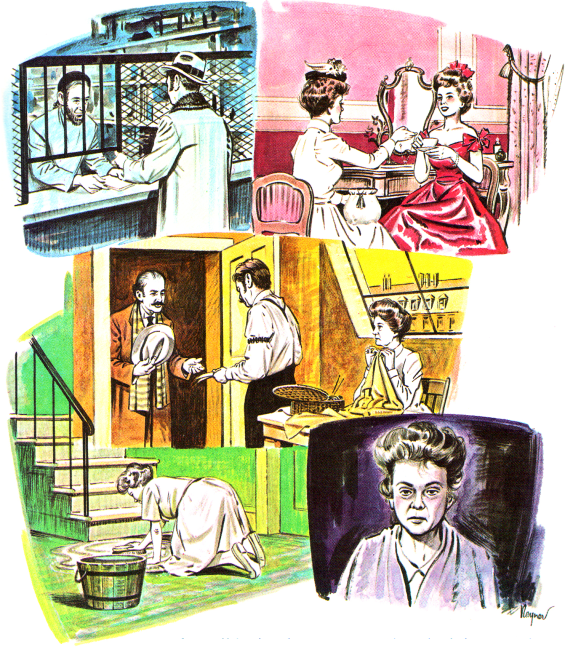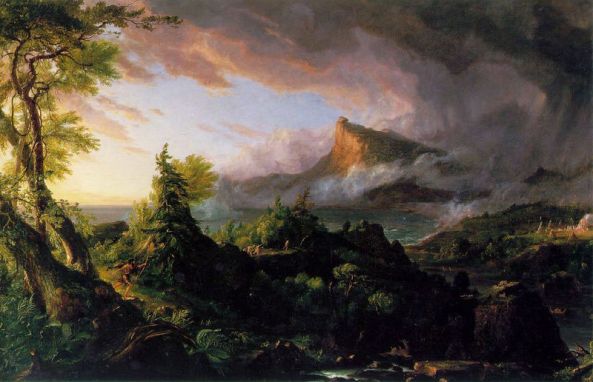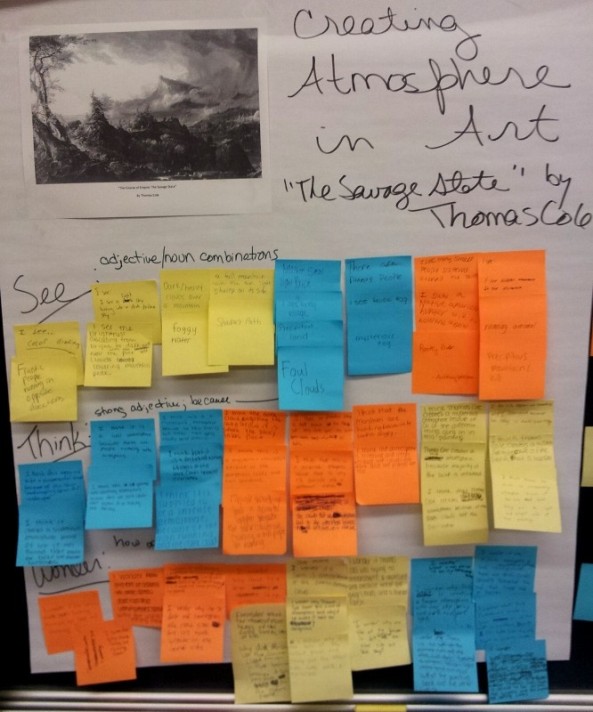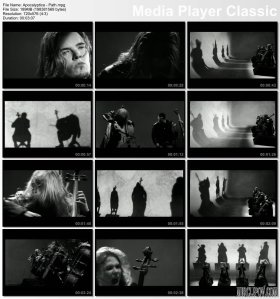We have begun The Odyssey!
Homeric Similes from Books V-VIII in The Odyssey
For each of the following, groups had to illustrate the portion of the Homeric simile that offers the comparison to a specific character (not a picture of the character). After reading the simile, they had to work together to identify the character that is used in the comparison and explain how the simile is effective (ie. WHY is this a strong comparison?) They had to use the quotation (the Homeric simile) from the epic as a caption for the group poster, and on a classroom website (Sharing in the Journey of the Hero), one group member had to post the group’s explanation of how the comparison is effective in portraying the character (those who “report” on the website rotates in the group for the various discussions).
Because the “reporter” is responsible for sharing the group’s thoughts and ideas, they are also responsible for “representing” the group with correct spelling, punctuation, and grammar, as well as outstanding content. A little added peer pressure seems to make for stronger online responses. I had noticed a decline in quality of individual online responses, so I decided to up the ante.
1. Book IV page 35 (lion protecting den)
2. Book V page 46 (sea gull)
3. Book V page 54 (fugitive)
4. Book VI page 57 (Artemes at hunting)
5. Book VI page 57 (wild lion)
6. Book VI page 59 (goldsmith’s work)
7. Book VIII pages 78-79 (wailing woman)
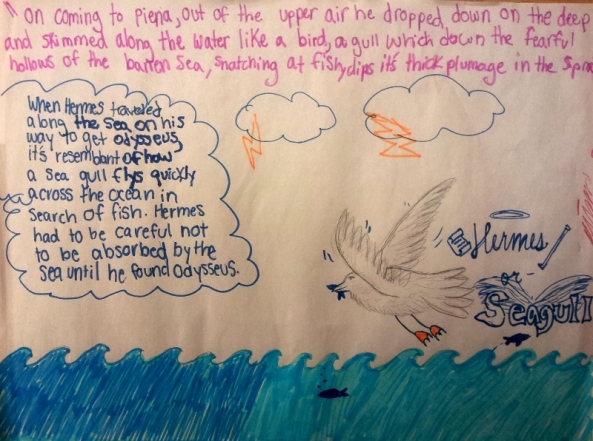
Student response: Homer compared Hermes to a seagull. He states that Hermes dropped down on the deep, and skimmed along the water like a seagull, who was in search of a fish. Hermes always helps Odysseus, and is like a messenger, or guide to him. He was told to tell Odysseus how to reach home. First by building a raft, which would take him to the land of the Phaeacians, who would treat him like a god. Then, he would finally travel to his native land. Hermes was looking down upon the water for Odysseus, the same way a seagull would do when it was in search of a fish. As he found Odysseus, he dropped down, and then delivered his message, just as a seagull would drop down to catch a fish it had spotted.
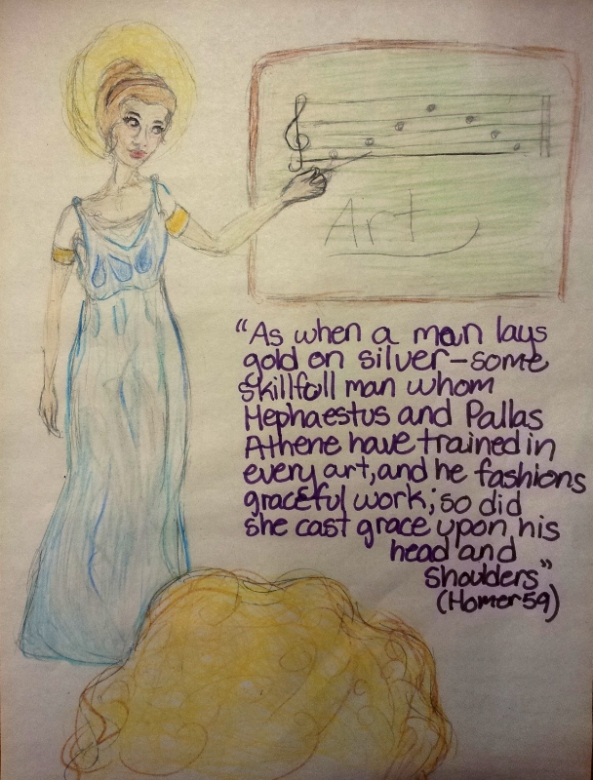
Student response: In this Homeric simile, Homer is comparing the beauty Athena puts upon Odysseus to an artisan who Hephaestus and Athena themselves have trained themselves in every art. The Artisans fashions graceful work as Athena has “cast a grace” (Homer, 59) on Odysseus. After bathing, Odysseus is made taller and stouter, his hair curling into magnificent locks around his head. The comparing to a goldsmith was clearly hinted when the text read “as when a man lays gold on silver” (Homer, 59) and mentions the skillful work Athena preforms. Odysseus finally steps into the light, and shows off his new heroic figure to the maids waiting further inland.
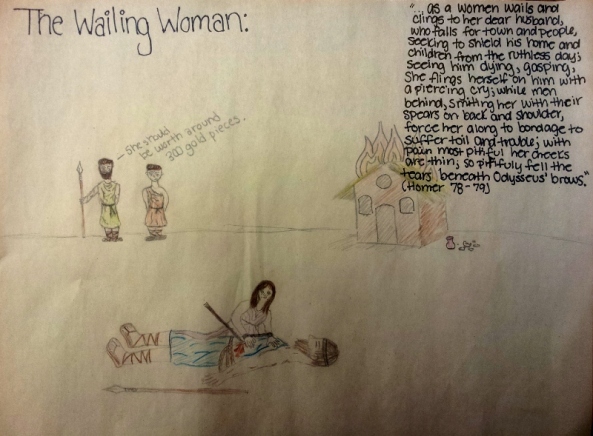
Student response: This Homeric simile compares Odysseus and his grief after hearing the story of the Trojan Horse and winning of the Trojan War to a woman sobbing at the death of her husband and destruction of her life by invaders. Essentially, the woman is throwing herself on her husband while wailing in grief, after he had unsuccessfully tried to defend his home from plunderers and died. Furthermore, this woman has been captured and will be forced into slavery by the same invaders that killed her husband. The woman’s pitiful state is parallel to Odysseus’, and the comparison becomes especially poignant due to the imagery of warfare. Comparing Odysseus, a man who very well could have died in battle, to the grieving wife of a man who died in battle, provides an irony that clearly shows the true depth of Odysseus’ sadness.
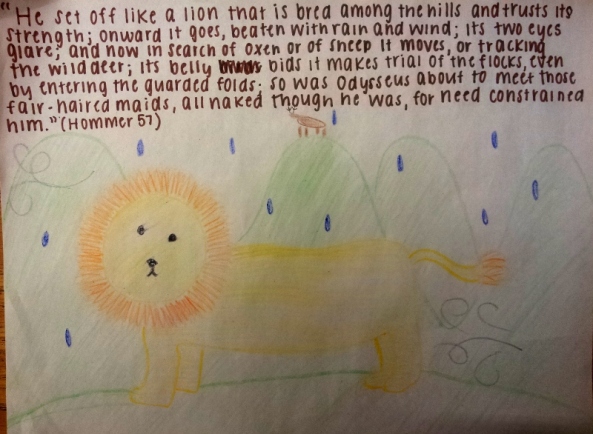
Student response: Book VI p.57 This picture is representing the comparison between a wild lion and Odysseus. Odysseus like a lion is very trusting in his strength, to help himself drag his body to safety and civilization. Like the lion he is angry and exusted by his trials in order to survive. Odysseus’ clothes were in shreds like the lions fur. Odysseus like the lion was willing to go into possibly dangerous situations in order to survive.
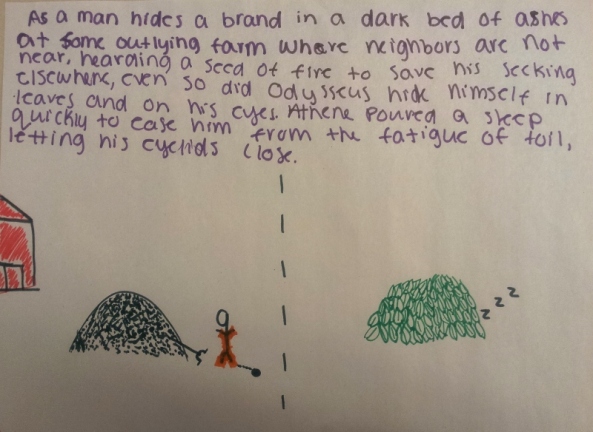
Student response: Homer represents Odysseus as a fugitive. Homer compared Odysseus as a fugitive because of his actions. Odysseus was acting like a fugitive by trying to hide his idenity. The first thing Odysseus does is he trys to hind his brand, just like how if a prisoner were to escape, most of them would try to hide their tattooed numbers so nobody knows that he/she had been in prison. Next, Odysseus found a farm not near any people or neighbors. He chose this place because he knew that if he were to choose a area with lots of people, then he would be more likely noticed, and somebody could have reconized him. This action relates to the plan of a fugitive because, once people found out that a prisoner was missing, they would be posting pictures of the fugitive’s face all over the town. In order for the fugitive to not be reconized, they would have to find a place like Odysseus’, that didn’t have many people around that could reconize him. Finally, Odysseus had hid himself in some leaves to disguise him for the night so he can get some rest. This can be related to the actions of a fugitive because a fugitive would have to find a place to hide so nobody see’s him while he sleeps.
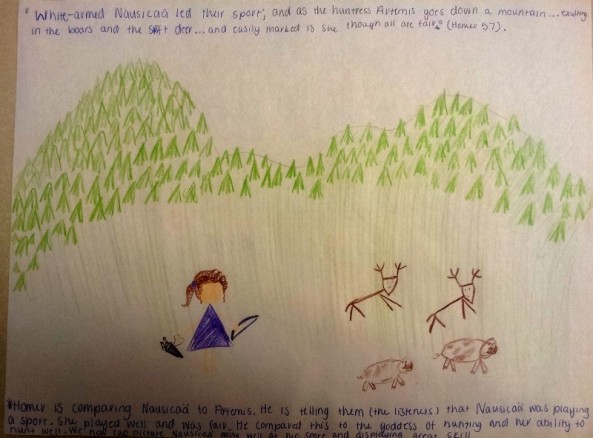
Student response: Book VI p.57 “White-armed Nausicaa led their sport; and as the huntress Artemis goes down a mountain…exhulting in the boars and the swift deer…easily marked is she though all are fair” (Homer 57).
This quote is comparing the princess, Nausicaa, to Artemis who is the greek goddess of hunting. T. Homer states how Nausicaa lead a sport with some of her women after washing clothes and eating. Homer compares Nausicaa’s ability and skill of the game to Artemis and her hunting ability. Artemis is the goddess of hunting. Since she is the goddess of hunting, many can infer that Artemis is great at hunting. Listeners can imagine Artemis showing great skill while going down a hill and shooting deer with her bow. Homer allows the listeners to picture Artemis gliding through the forest and hunting animals with ease. Since Nausicaa is said to seem like Artemis, we can imagine her playing the sport very well and shining as a great player. This simile is a great example of evoking the listener to visualize. Since Homer would have told this tale to groups of Greek listeners, they all can picture Nausicca better. They all would have known who Artemis was which would help them make the connection between the two characters described. This is a great example of a “Homeric Simile”. It is a longer simile but it really explains the thing being described and compared.

Student response: Homer represents the suitors as the hind and its fawn. The suitors have all stayed at Odysseus’ home without permission or welcome, just as the hind and fawn. The lion represents Odysseus and how he has been away from his dwelling for a long time. The lion brings “ghastly dooms”(Homer 35) upon the hind and fawn. This is depicting how it will be if Odysseus is ever to come and find the suitors, which is what happened when Odysseus faces the suitors. The simile paints the picture of what is to come when Odysseus confronts the suitors.







